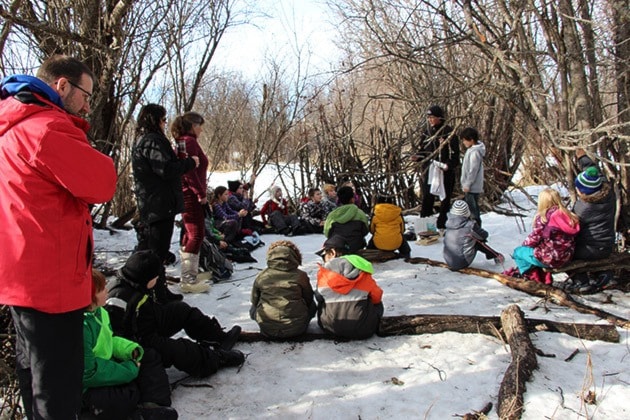More First Nations-themed material enters schools’ agenda this season, and for some of Vanderhoof’s elementary school students, it starts with woodworking.
Local carver Jeremiah Prince taught Grade 3 students from W. L. McLeod Elementary a first lesson in carving at their outdoor classroom by the W. L. McLeod Wetland on Feb. 18.
It’s the first of an aboriginal-themed series of classes by guest teachers this season for the Grade 3 class, teacher Patty Borek explained.
With upcoming lessons on herbal medicine and plants, as well as a traditional game called lahal involving sticks and stones, the classes are a way to incorporate aboriginal content into the new school curriculum that was introduced this year, Borek said.
“It’s neat because he’s learning as well; he says, ‘I’m not an expert yet,” she said. “It’s good for the kids to see that grownups practise things and learn things, and they make mistakes and they keep trying.”
Prince presented to the class examples of his artwork in different stages of completion.
“What I started when I was a kid was drawing,” he said. “Then drawing on wood.”
Demonstrating various ways of cutting with an emphasis on control, Prince said to students that although cuts on fingers are common, especially for beginner carvers, the end result is rewarding.
“Anyone can do whatever they want, as long as they apply themselves,” he said, as a student asked about the difficulty of carving masks. “They are time consuming, but are pleasing to the eye.”
In partners, students were first introduced to the concept by using tip-protected knives on collected wood from the ground.
For student Emily Blitz, who was working with wood for the first time, using a knife is slightly scary, though she enjoys art activities such as painting, she said.
The B.C. government announced last fall the new curriculum that schools can trial run this year, before a full implementation for students in Kindergarten to Grade 9 in 2016.
The new curriculum includes aboriginal perspectives, residential school legacy, history of Asian immigration, emphasis on environment, and increased opportunities of creativity for teachers and students.
Outdoor classroom
Located two minutes of walking distance from W. L. McLeod Elementary and accessed through a trail by the neighbouring wetland, the outdoor classroom was established last fall as a space for students to visit regularly, connect with nature, and see science at work, Borek explained.
“There’s a philosophy of education that if you can get kids connected to a particular space in their landscape…they see it in different weather and different climate,” she said. “They get very comfortable with it and they become attached to it.”
With woven walls and decorated by small Christmas ornaments as well as bird feeders, it’s a space picked by students and frequented by animals such as snowshoe hares, chickadees, owls, and deer, Borek said.
“The whole marshland area is a beautiful environment for learning and playing for all seasons,” she explained. “We can be there in the fall and do lots of stuff on the river banks, when the river is low and there’s tons of dead fish, maggots, bugs…lots of science happening.
“In the winter, it’s playing in the snow and looking at tracks.”
